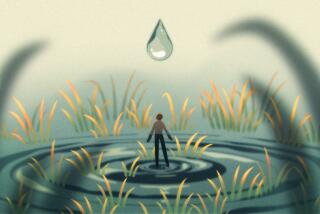There Are Easy Ways to Save Water, Energy
- Share via
QUESTION: I am looking for simple inexpensive ways to reduce my home water use. Any ideas?
ANSWER: There are many simple, low-cost or no-cost ways for you to reduce your home water use. The first step is to look at where you use the most water. In a typical home or apartment, the bathroom, kitchen and laundry require the most water. Remember, just using less hot water saves you money and energy.
Bathroom: shower and sink
* Take shorter showers. Purchase a low-flow shower head at the hardware store; this device reduces your water consumption without affecting your comfort. For the truly conservation-oriented, try a “Navy” shower: turn the water on to get wet; turn the shower off to lather up; turn the water back on to rinse.
* Turn off the water when brushing your teeth, washing your face or shaving. Just run enough water to rinse.
Bathroom: Toilet
Toilets manufactured before 1993 waste as much as 1 or 2 gallons of water per flush. To reduce the amount of water used in your toilet:
* Fill a glass quart jar with marbles and set it inside the tank. The jar will displace about a quart of water per flush. Just make sure it isn’t blocking the float arm or the toilet won’t operate correctly. If you prefer, purchase a toilet dam or displacement bag from your local hardware store. These devices can reduce the volume in each flush by as much as 1 to 2 gallons.
* Check the toilet for leaks. You can check by listening for the sound of leaking water or by putting a small amount of food coloring in the tank and watching the bowl. When a leak is present, the food coloring will get into the bowl in a few minutes. This technique may not work if you use the kind of chlorinated toilet bowl cleaner that is set in the tank, particularly if it turns the water blue, If you detect a leak, get your toilet fixed as soon as possible.
* Check the float arm for proper adjustment. The float arm should shut off the after-flow about a half-inch below the overflow tube. If water is flowing down the overflow tube, try binding the float arm, which closes the ballcock (the float-controlled valve that lets water into the tank) downward. If the water level is below the top of the overflow tube but still runs into the bowl, the flapper valve is probably worn and needs replacement.
* Use a wastebasket to dispose of facial tissues and other small items rather then flushing them.
* Replace your existing toilet, which uses about 5 gallons with each flush, with a new ultra-low-volume unit that uses only 1.6 gallons per flush. This change alone can cut your indoor water use by about 25%.
Kitchen
* Fill kettles only to the depth required. Boiling unused water wastes water and energy (not to mention time).
* Use ice trays that permit the cubes to be loosened by levering or twisting rather than running water over the tray.
* Use a pan of water instead of running water for washing vegetables.
* Use your garbage disposal sparingly. Better yet, compost vegetable scraps for the garden instead. (Do not compost meat or dairy products.)
* Run your dishwater only with full loads. Brush loose material off without rinsing before loading dishes into the washer.
Laundry
* Do not use long pre-wash cycles in the washing machine unless necessary.
* Avoid washing small loads but when you do run them, adjust the water volume accordingly. Use the cold setting when you can.
* When washing clothes by hand, fill the sink with the amount of water necessary, then turn off the water. Don’t run the water again until you need to rinse your clothes.
Saving water doesn’t have to be complicated or expensive. The most cost-effective way to save water is to change old habits. With a little effort, you will be surprised at how many “new habits” will become second-nature after you begin using them.
*
Written by Sara Busch from the Education and Information Network of the Washington State Energy Office.






